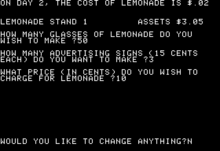Lemonade Stand
| Lemonade Stand | |
|---|---|
| Developer(s) | Bob Jamison, Charlie Kellner |
| Publisher(s) | Minnesota Educational Computing Consortium |
| Platform(s) | Mainframe, Apple II |
| Release date(s) | 1973 |
| Genre(s) | Business simulation game |
| Mode(s) | single player |
Lemonade Stand is a business simulation game created in 1973 by Bob Jamison of the Minnesota Educational Computing Consortium (MECC). In it, the player moves through several rounds of running a lemonade stand, beginning each round by making choices dependent on their current amount of money about their stock, prices, and advertising. In each round, the results are randomized based on the player's inputs, as well as affected by random events such as thunderstorms and street closures. Each round ends with a summary of the player's current status, and the game ends after 12 rounds.
In 1979, the game was ported by Charlie Kellner to the Apple II; Apple subsequently included the game with their computers throughout the 1980s. MECC also offered the game for sale as a part of bundles of children's software for Apple computers and Atari 8-bit computers. Kellner's source code was released, and has since been ported to modern computers as a free, open-source game. Reviewers of the game, both contemporary and retroactive, viewed the game as a good primer for children into business and decision making processes.
Gameplay

The game simulates a child's lemonade stand, where choices made by the player regarding prices, advertising, etc. will determine the success or failure of the enterprise. The game owed its success to offering just enough variables to make a complex challenge for users, but still providing a simply-grasped introduction to running a business.[1][2]
The player is first given a weather report for the day (sunny, cloudy, or hot and dry, each accompanied by a color drawing) and is prompted for three values: the number of glasses of lemonade to make, the number of advertising signs, and the cost of lemonade per glass. The program then gives a report of the earnings for that day. A thunderstorm, sometimes occurring on cloudy days and accompanied by an animation, will void any profits and cause the player to lose any investment for the day. Other random events, such as street closures or the wind blowing away some signs, can also occur. The game ends after 12 rounds, or days. The game can be played either single-player or with up to 30 players (each player is independent and the sales of one do not affect another).[3][4] The Apple II version included music, with bars from "Singin' in the Rain," "Raindrops Keep Fallin' on My Head," and "Summertime" played at appropriate moments. It also added color to the thunderstorm animation.
Development

Lemonade Stand was originally developed by Bob Jamison of the Minnesota Educational Computing Consortium in 1973 for time-shared mainframe computers.[5][1] Charlie Kellner ported the game to the Apple II platform in February 1979, and Apple included it for free with their computers throughout the 1980s.[2][6]
Legacy
In 1982 David H. Ahl reviewed the game along with five other business management simulations in Creative Computing; he indicated that it was simpler than most, and likely aimed at children, and said that it was a good teaching game for children about businesses. He also noted that it was free on Apple computers, and available for sale for the same system as part of a bundle of seven games for children for US$25 from MECC.[3] MECC also sold the game as part of a package for Atari 8-bit computers.[7] Elizabeth Ghaffari, in Tapping the Wisdom that Surrounds You, claimed that the game was "the perfect vehicle to introduce the microcomputer to family and friends and to convince them that technology could be a fun and positive force in their life."[4]
Kellner's Applesoft BASIC source code has been available since 1979. The game was later ported to modern REALbasic[8] and released as free and open-source software for many platforms like Windows and macOS.[8][9]
See also
- Lemonade Tycoon, a similar, more recent game
- Dope Wars, a game with similar mechanics
References
- 1 2 Lemonade Stand and the Apple revolution on The Sydney Morning Herald (December 24, 2008)
- 1 2 Short history of Lemonade Stand, by Theodor Lauppert (archived)
- 1 2 David H. Ahl (April 1982). "Six Business Management Games" (jpg). Creative Computing. Vol. 8 no. 4. Ziff Davis. pp. 28, 30.
- 1 2 Elizabeth Ghaffari (2014-09-24). Tapping the Wisdom That Surrounds You: Mentorship and Women. ABC-CLIO. pp. 53–54.
- ↑ Lemonade Stand on Home of the Underdogs
- ↑ "The Apple Tapes: Introductory Programs for the Apple II plus". Apple Computer Inc.: 4–5.
manual original
- ↑ Atari Program Exchange. "Instructional Computing Demonstration" (jpg). Minnesota Educational Computing Consortium: 25–26.
- 1 2 Lemonade Stand on Codenautics "Lemonade Stand is both free and open-source"
- ↑ Tranter, Jeff. "README.txt". LemonadeStand. GitHub.
External links
- The Apple II version of Lemonade Stand can be played for free in the browser at the Internet Archive
- Codenautics' port of the Apple II game to Windows and Mac OS